This is a Wirgin Presto folding camera made by Wirgin Kamerawerk out of Wiesbaden, Germany in the mid 1930s. Narrowing down the exact year this camera was built is difficult due to very little information being available. The Presto was the upscale version of the nearly identical Wirgin Auta. All Prestors and Autas used 120 roll film, and could take 6cm x 9cm images, but some, like this one could also shoot 6cm x 4.5cm images with the use of a removable mask. The dual format Prestos are easily distinguishable from the single format ones because they have two red windows on the back of the camera. The Presto had a self-erecting bellows and shutter which springs to the open position when opening the camera. It also has a Prontor II shutter, a fast Gewironar lens, and a top shutter releasing making it quite an ambitious camera for its day. Wirgin would continue to make Prestos after World War II, although the design would change slightly and have different lenses available.
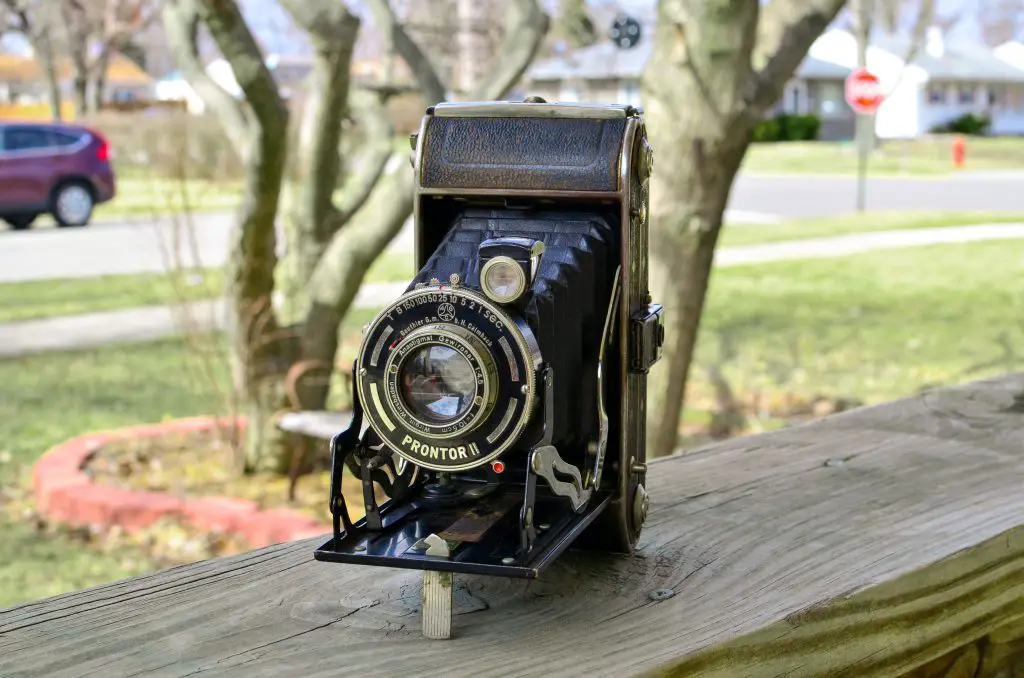 Film Type: 120 roll film (dual format 6cm x 9cm or 6cm x 4.5cm with optional mask)
Film Type: 120 roll film (dual format 6cm x 9cm or 6cm x 4.5cm with optional mask)
Lens: 10.5 cm f/4.5 Anastigmat Gewironar uncoated 3 or 4 elements
Focus: 7 feet to Infinity
Viewfinder: Scale Focus
Shutter: Prontor II
Speeds: T, B, 1 – 1/150 seconds
Exposure Meter: None
Battery: None
Weight: 672 grams
Manual: http://inauspicious.org/files/scans/auta/
How these ratings work |
The Wirgin Auta is a very attractive, but relatively uncommon German folding camera from the 1930s. It exhibits many of the same qualities of the best of what Germany had to offer at the time. The Auta was continuously updated throughout it’s lifespan so there will be many with slight variations. My example has several modern features that were not common in the 1930s, such as a self erecting lens standard, a top plate shutter release, dual format capability, and dual viewfinders. I believe the Prontor and Gewironar lens combo should be capable of excellent results, even if mine didn’t show it consistently. I feel as though my particular model has a couple of mechanical issues causing film flatness problems, but that wouldn’t stop me from declaring that the Auta is a quite nice camera. I love the nickel and leather look of this camera, and the advanced features make it more user friendly than a typical 1930s 6×9 folder. Perhaps with a better example, I would have gotten better results. Only time will tell. | ||||||
| Images | Handling | Features | Viewfinder | Feel & Beauty | History | Age | |
| 1 | 0 | 2 | 0 | 2 | 1 | 40% | |
| Bonus | none | ||||||
| Final Score | 8.4 | ||||||
Edit 1/29/2017: This review was originally published in July 2016, and I had concluded that this was a Wirgin Auta folding camera.
Just today, I received an email from Eugene Ilchenko from Collectiblend, and he told me that my Auta, was most likely a Wirgin Presto. He said the Prestos were the higher end version of the Auto, and normally came with higher spec shutters, lenses, leather body coverings, and had nickel plated body accents. He suggested that in his research, Autas normally had black painted bodies, imitation leatherette covering, and lower spec 4.5 and 6.3 lenses.
I will leave the rest of this review as I originally wrote it since most everything is still true, but based on this new information, I am renaming this review from the Wirgin Auta, to the Wirgin Presto.
History
Wirgin was a camera company based out of Wiesbaden, West Germany, and was founded in 1920 by Jewish brothers Heinrich (Henry) and Josef Wirgin. At the time, Henry was 23 years old and had a business background with some expertise in manufacturing. Josef was his younger brother and had a lot more knowledge in the technical areas. Together, their original goal was to import cameras into Germany and sell them under the Wirgin name. At some point later, two more Wirgin brothers, Max and Wolf joined the company. Max had a chemistry background and Wolf took care of the finances.
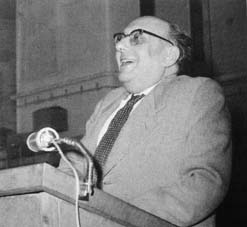
Before I go any further, just let this sink in for a moment. Jewish brothers….Nazi Germany….
It’s probably no surprise that digging up accurate information regarding the history of Wirgin is a bit difficult. Both the Wikipedia and Camerapedia articles are almost word for word the same. Most other sites that mention any part of their history usually recite facts from these same articles. Further complicating matters is that in 1938, the Wirgin brothers fled their home country due to increasing anti-Jewish harassment, and sold their entire business (another site says the factory was confiscated, not sold) to another German camera company called Adox, but bought it back after the war. I’ll do my best to combine all of the information I’ve found here, in the hopes that I get at least part of the history correct.
During my research into the history of Wirgin, I came across a couple of other German language sites with more information than what was available on either Wikipedia or Camerapedia. A particularly interesting one was the German language site by Leif Johansen. Since my only knowledge of the German language comes from playing Wolfenstein video games and watching Indiana Jones movies, I had to rely on Google’s translate feature to translate most of the site to English.
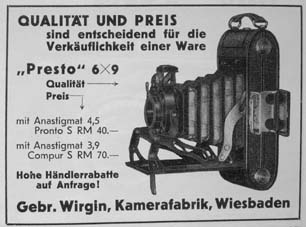
According to Johansen, in 1926 Wirgin released their first cameras which were a variety of 6.5cm x 12cm and 9cm x 12cm folding plate cameras sold under the names Gewir and Metadux. Around 1930, Wirgin would release their first roll film cameras. First, a box camera, and then the 127 format Gewirette, a handsome nickel and leather covered compact camera that would have design elements of the later Wirgin Edinex.
Their first 120 format roll film cameras would be released in 1935. To the left is an advertisement for a “Presto 6×9” folding camera that looks very similar to the Auta. You can clearly make out the self erecting hinges and struts which look identical to my Auta model. According to Johansen’s site, the Presto wasn’t released until 1938. I have my doubts about this as that would have been the same year the Wirgin brothers fled Germany to the US. Were the Auta and Presto the same camera, just with two different names for different markets, or was one a “lesser” model of the other? When were these cameras actually made? Who knows. All I can conclusively say is the entire period from the late 20s through the late 30s was a very busy time for Wirgin. They continued to make folding plate cameras, roll film cameras that used 120 and 127 film, 35mm cameras, and even a TLR.
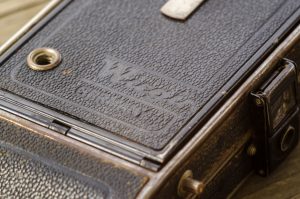
As I mentioned earlier, Wirgin’s company history is very hard to piece together as there simply is not a lot of information about the company, and as such, coming up with a comprehensive list of all models and when they were sold is difficult. One of Wirgin’s many folding models was called the Auta and started production around 1935. Prewar models were made until around 1938 when Josef and Heinrich had to flee Germany. The Auta must have been one of Wirgin’s more popular models as it was also made after the war when the Wirgin brothers would return to Germany. I have found evidence that Wirgin Autas were in production in the late 1940s, although I cannot tell when production officially stopped. The Auta being reviewed here is definitely a prewar model, as evidenced by the marking on the lens being in centimeters as opposed to millimeters.
The Auta was a very well built camera and had some ambitious features for a mid 30s folding camera which probably means it was one of Wirgin’s higher end models. The Gewironar 10.5cm f/4.5 lens was Wirgin’s best lens, and the Prontor II shutter was a highly regarded shutter at the time. The camera has an auto-erecting lens and shutter, much like smaller 35mm folding cameras such as the Kodak Retina and Certo Dollina. There is a door release on the top plate of the camera, that when pressed, opens the door which also extends the bellows and pushes the lens and shutter into a fully erect position. There is no need to manually extend the bellows like in other 20s and early 30s large folding cameras. The name Auta could possibly be taken from this feature as an “auta-matic” erecting folding camera.
The Auta also has a top shutter release which was very unusual for the mid 1930s. Although the shutter can still be fired by moving the pin on the shutter itself, there is a linkage that connects it to a button on the left side of the top plate of the camera. It was common for early top mount shutter releases to jam or become bent over time, but the one on this Auta is in perfect working order. The shutter release is very smooth and fires consistently each time.
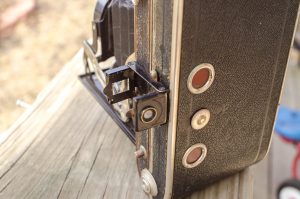
Finally, the Auta was a dual format camera that could shoot 6×9 or 6×4.5 images with a mask. Although my camera is missing the 6×4.5 mask, it still works fine as a 6×9 camera. For cameras that still had the mask, the viewfinder had a flip up 6×4.5 mask as well for composing a shot.
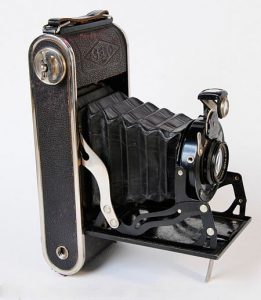
In my research for the Auta, I discovered that this model was produced by Wirgin for sale under a variety of brands. This is one of the earliest forms of licensing that I have come across with old cameras. Wirgin must have created partnerships with other companies to make cameras for them, which they would then put their own names on and sell under their own brand. The most obvious example of this was with a camera called the Selo 20 which was sold by a French company called Wellington & Ward S.A. As it turns out, Wellington & Ward was a division of Ilford, a British company that made a variety of film types back then. Although not known as a camera maker, it would make sense that Ilford might partner with another camera maker and do some brand engineering so that they could pair a camera with film that they made. You can read more about the Selo 20 camera and a little bit of it’s history on this page.
There was another camera called the Rodenstock Gero which looks to be identical to the Auta. I encountered other examples of cameras which strongly resemble the Auta, but had absolutely no markings on them whatsoever. This hints that Wirgin made “white label” versions of their products and licensed them to a variety of companies for sale.
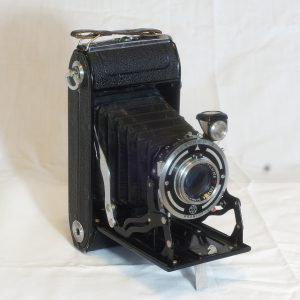
By 1938, both Josef and Heinrich Wirgin would flee Germany for the United States. The factory would be taken over by Adox and many Wirgin cameras like the Auta and Edinex would be rebranded as Trumph and Adrette cameras respectively, but would otherwise be unchanged. After World War II when Joseph and Henry (they changed their names) returned to Germany and would re-acquire the rights to the Wirgin brand and factory, they would continue to make Autas until at least 1949. I have not seen any conclusive evidence of changes to the Auta after the war, but it appears that most of the later models had black painted metal accents instead of nickel or chrome plating. I also assume the inclusion of lenses with markings in mm and coated optics would suggest postwar models.
Today, there is little to no interest in 1930s folding Wirgin cameras. Their most successful models, the Edinex and Edixa SLRs are the two models that generally bring the highest prices on the used market, but when a model like the Auta comes up for sale, it rarely generates a lot of interest. This is great for collectors looking to get a well built and interesting pre-war model, but since they don’t come up for sale often, finding one can be difficult. Still, there is a general high regard for any camera made in Germany during this period. Even if you aren’t specifically searching for a Wirgin Auta, seeing one in nice condition is a worthy pickup. The optics are generally always good, and the cameras almost always can still be used.
Repairs
There are many people who are self professed Nikon, or Leica, or Rollei, or Pentax guys. While I think I’m an equal opportunity collector, I seem to be drawn to underdog brands. I find myself more interested in cameras made by companies like Universal, Leidolf, Ciro, and Wirgin. This Wirgin Auta is my third Wirgin camera in my collection after the Edinex II and Edixa Reflex SLR.
I have a soft spot for folding cameras, especially German ones from the 1930s with nickel plating. This camera tickled three of my hot spots and upon seeing that it looked to be in excellent shape, I picked it up for the low low price of (I can’t remember what I paid for it).
When it arrived, the camera had a frozen shutter, but otherwise looked to be in great shape. The leather on the body showed some brownish wear marks, but it wasn’t peeling anywhere and was completely in tact. I have quite a bit of experience cleaning shutters on 1930s German folding cameras with Compur shutters, and although I’ve never taken apart a Prontor, how hard could it be?
I’ve talked about cleaning shutters from German folding cameras in other articles. I went over a step by step process in my review for the Certo Super Sport Dolly, and in the review for the Kodak Retina Type 119, both of which are German folding cameras with Compur shutters. I also talk about doing this in my article “Breathing New Life Into Old Cameras” where I actually use some examples from this Wirgin Auta. While all of these cameras vary in design, size, and even shutter, the basic steps are still the same.
You need to detach the shutter from the camera by removing a ring inside the film compartment of the camera. Unscrew all the lenses and remove any screws holding the front plate on. Once you have the insides of the shutter exposed, you soak it with Ronsonol lighter fluid or naphtha oil until it’s clean. Since I’ve covered this process several times in other articles, I won’t repeat it again, but I will include some pictures specific to the Auta for you to see, but you can refer to the aforementioned articles for more specifics.
After cleaning the Prontor shutter and making sure all of the speeds worked correctly, I gave the insides of the body a good wipe down. I found some cobwebs inside of the camera and a lot of general dirt, but everything was there and seemed to be in good working order. After reassembling everything and making sure everything still worked, I put it in “the queue” to be shot later.
My Thoughts
The Wirgin Auta is similar in design to my very first vintage camera, a Kodak No.1A Autographic Special which I acquired in the fall of 2014. Since then, I’ve picked up a variety of other 6×9 or 6.5×11 folding cameras from the 1910s through the early 30s. When the Auta arrived, I noticed that it was a bit more advanced than many of those other early folders. For one, this is a self-erecting design. When you fold open the front of the camera, the entire shutter and lens standard automatically extend to the taking position. There is no additional step to pull the lens and shutter to a taking position. While self erecting cameras became the norm with the release of ‘miniature cameras’ like the Kodak Retina and it’s clones, medium format cameras wouldn’t generally have this feature until after the war.

Another feature which I didn’t expect to see was a top shutter release. Once again, top shutter releases were more common on 135 format cameras and post-war cameras, but to have a pre-war German medium format folding camera that has both a self erecting lens standard, and a top shutter release was pretty unique for the time.
To my delight all of the mechanical functions of the camera like the shutter release and unique hinge were all in good working order. It was clear that this camera had been taken care of throughout it’s life. After cleaning the shutter and getting everything in good working order, I was pretty excited to take this camera out. While at first it might seem like just another medium format German folder, it quickly began to reveal itself as quite an advanced camera for it’s time.
My particular Auta was a dual format camera and has two red frame windows in the film door for 6cm x 9cm and 6cm x 4.5cm. The flip up viewfinder also has an insert for a 6cm x 4.5cm frame. While the camera is a native 6cm x 9cm camera, if you want to shoot in the smaller format, you must insert a mask into the film compartment for the 6cm x 4.5cm images. Unfortunately my particular example did not have the insert. Somewhere along this camera’s 80 or so years of existence, the mask had become lost, which sadly is a common occurrence on cameras like this. When loading film into the camera, you have to use the the frame window closest to the corner (not the one in the middle). You also have to remember to flip down the 6cm x 4.5cm insert in the folding viewfinder in order to see the full 6cm x 9cm frame.
Shooting with the camera is essentially the same as other folding cameras of the era with the exception of the top plate shutter release, which worked remarkably well. Many folding cameras with top plate shutter releases have issues due to misuse over the years. In order for the manufacturer to make it work, a complicated series of levers and linkages must exist linking the button on the top plate to the shutter itself, but it must also be able to fold when the camera is shut. If a user is careless when closing the camera, this linkage can bend or break. As a result, many folding cameras like the Kodak Retina and it’s clones, have issues with the shutter linkage. Thankfully, the one on my Auta worked flawlessly.

The Prontor II shutter has a rim set dial for changing shutter speeds. The possible selections are 1 second through 1/150 plus B and T. While 1/150 might seem slow, it would have been more than adequate for outdoor shooting with the films available in the era. During my research for this review, I could never find any pricing information for this model, but from what I’ve learned about other Wirgin models, they were often the “value” camera offering medium range features for a lesser price than competing models. The lack of speeds higher than 1/150 suggest that this was an economy model at the time.
Focus is adjusted via the front lens element. Something that initially tricked me with this camera is that the focus scale is in feet, not meters like most other prewar German cameras. This could mean that this was an export model for sale in the United States. Josef and Henry Wirgin had a strong relationship with American importers like Burke & James in Chicago and G. Gennert in New York so this explanation is very likely. I do not believe this camera was made in the US however, as the camera still identifies Wirgin of Germany embossed in the leather, and Wirgin Wiesbaden painted in green and gold lettering on the underside of the front door.
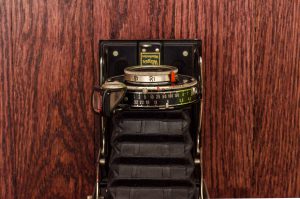
Aperture is changed via a slider on the top of the shutter. The slider has large knurled edges which are easy to locate and move. After completing the Ronsonol flush of the shutter, all of these movements were very smooth and required little effort. There is also a self timer on the right side which I did not use.
The Auta has two viewfinders, one is a traditional “brilliant” waist level viewfinder mounted to the lens standard and the other is a flip up viewfinder which has a mask for 6cm x 4.5cm shots. When shooting with the camera, I relied on the flip up viewfinder as I found the brilliant viewfinder to not only be very small, but it exhibited desilvering of the mirror making it very difficult to use.
I don’t often take out large 6×9 folders partially due to their less than pocketable size, but also due to the fact that the aspect ratio is nearly the same as a 6cm x 4.5cm camera, but you get half as many shots per roll. Yes, I realize a 6×9 folder’s image is twice the size of a 6×4.5, but at the resolution that most flatbed scanners work, I cannot see any improvement in detail between a 6×9 negative and a 6×4.5 negative.
I took the Wirgin Auta with me to a family reunion in Wisconsin. I intended to shoot a family portrait with this camera on a tripod and hoped the large negative would produce a highly detailed shot, plus the family seemed to think it was pretty neat to get their picture taken by such an old camera. While I won’t say that I had any problems shooting with the Auta, it’s use wasn’t any different from any other early folding camera. I didn’t walk away from that first roll feeling excitement to use it again, but perhaps after seeing the results, I would be more eager to shoot with it again.
My Results
This first roll was shot with a roll of recently expired Kodak Portra 160 film. I had used this same film in other cameras already and knew that it shot close to box speed, so I made no adjustment for it being expired.
Upon first glance, the images look quite nice. There are no visible light leaks in any of the images, suggesting the bellows are in tact and the film door is keeping light out. Also, every shot seems to be correctly exposed which suggests that my repairs to the shutter were successful. Overall, these images look similar to those shot with other cameras of the era, but once you look a little closer, there is a pretty significant focus issue which is visible in all of the shots. The odd thing is that this isn’t like most focus issues which affect the whole frame. If you look closely in all of the shots, just to the right of center, the image gets significantly blurrier than the rest of the image. This is especially apparent in the family portrait picture. If you look at the gentleman in the white t-shirt with the bald head, he is sharply in focus, but the man in the gray shirt and white hair immediately to the right of him is blurry.
The same anomaly shows in the garden pictures above. It’s there in the lake photo as well, but it’s harder to see due to the nature of the photo. I do not believe this to be a simple zone focus error as all of these people were approximately the same distance away from the lens and the camera was on a tripod. I shot the family portrait in good lighting about 25 feet away from the camera using f/11, so my depth of field should have easily been able to get everything in focus.

I took a 1:1 crop of the second garden photo to show you an area of sharp focus. The details in the fern and decorative grass are very strong, yet if you scan your eye over a couple of inches to the right, the image quickly becomes out of focus.
When seeing this initially, I had flashbacks to my experience with a Miranda Sensomat camera which had a missing film pressure plate. Despite my best effort, that camera would never focus entirely on the whole image as the film was not laying flat across the focal plane. I checked the Auta and the film pressure plate is there and appears to be working so I am not sure that this is the same problem.
I had a thought that possibly the dual aspect ratio of the camera was an issue. On my Certo Super Sport Dolly, it has a removable mask for both 6×6 and 6×4.5. Even though that camera is a native 6×6 camera, it still requires a 6×6 mask to work properly. Maybe the Auta requires a similar 6×9 mask to shoot 6×9 shots? Here is where the obscurity of the Wirgin Auta becomes a problem because it’s so hard to find another to confirm.

My friend Adam offered another possibility which is that the lens standard is bent, or not perfectly parallel with the film plane. In a folding camera like this, it is possible that the front lens standard is slightly out of line with the film plane which means that part of the image will be in focus, and the rest will not. While this is possible, I have my doubts because the out of focus area appears to be limited to slightly to the right of center. The image becomes sharp again near the right edge of the frame. If the lens standard was bent, as the image gets out of focus, it should continue to be out of focus to the edge of the frame, and not come back into focus. After staring at these images for a while, I feel as though the film was not laying flat across the film plane. Regardless of the reason, more investigation is needed. I will update this review once I know more.
In addition to the focus issues, I noticed a second problem which is that the viewfinder has a severe parallax issue with the actual image. While most folding cameras should not need parallax correction, especially for infinity shots, I found it difficult to properly frame this camera. The second garden photo in the gallery above shows this and I cut off the person on the far left of the family group photo, but the railroad tracks picture to the left really shows it. I specifically remember taking this shot and I was standing in the middle of the tracks and I made every attempt to center the tracks in the viewfinder. As you can see, I was quite a bit off.
This is a minor issue and not something that would be obvious on shots without such clearly defined lines. I would never use this camera for closeups or images that require very specific framing because of this issue. This is just something I’ll have to remember to compensate for if I ever shoot with this camera again.
Overall, my experience with the Wirgin Auta was a mixed bag. It is a beautiful camera with some advanced features for it’s time. The top shutter release works quite well, and I like the flexibility of having two viewfinders even though I had issues framing my shots. My repairs to the shutter gave me consistently exposed shots and when the lens was actually able to focus properly, it revealed a highly sharp image with quite a bit of detail. I do not know why patches of the images are consistently out of focus, but even with that issue, I can clearly see that the Wirgin Auta is a camera worth looking out for. If you can find one in good working condition, pick it up. It might not say Zeiss or Voigtländer on the side, but that doesn’t mean this isn’t a fine pre-war German camera.
Related Posts You Might Enjoy
External Links
http://www.jnoir.eu/en/cameras/wirgin/auta/
http://photo.net/classic-cameras-forum/009XuL
http://www.collection-appareils.fr/x/html/page_standard.php?id_appareil=15450

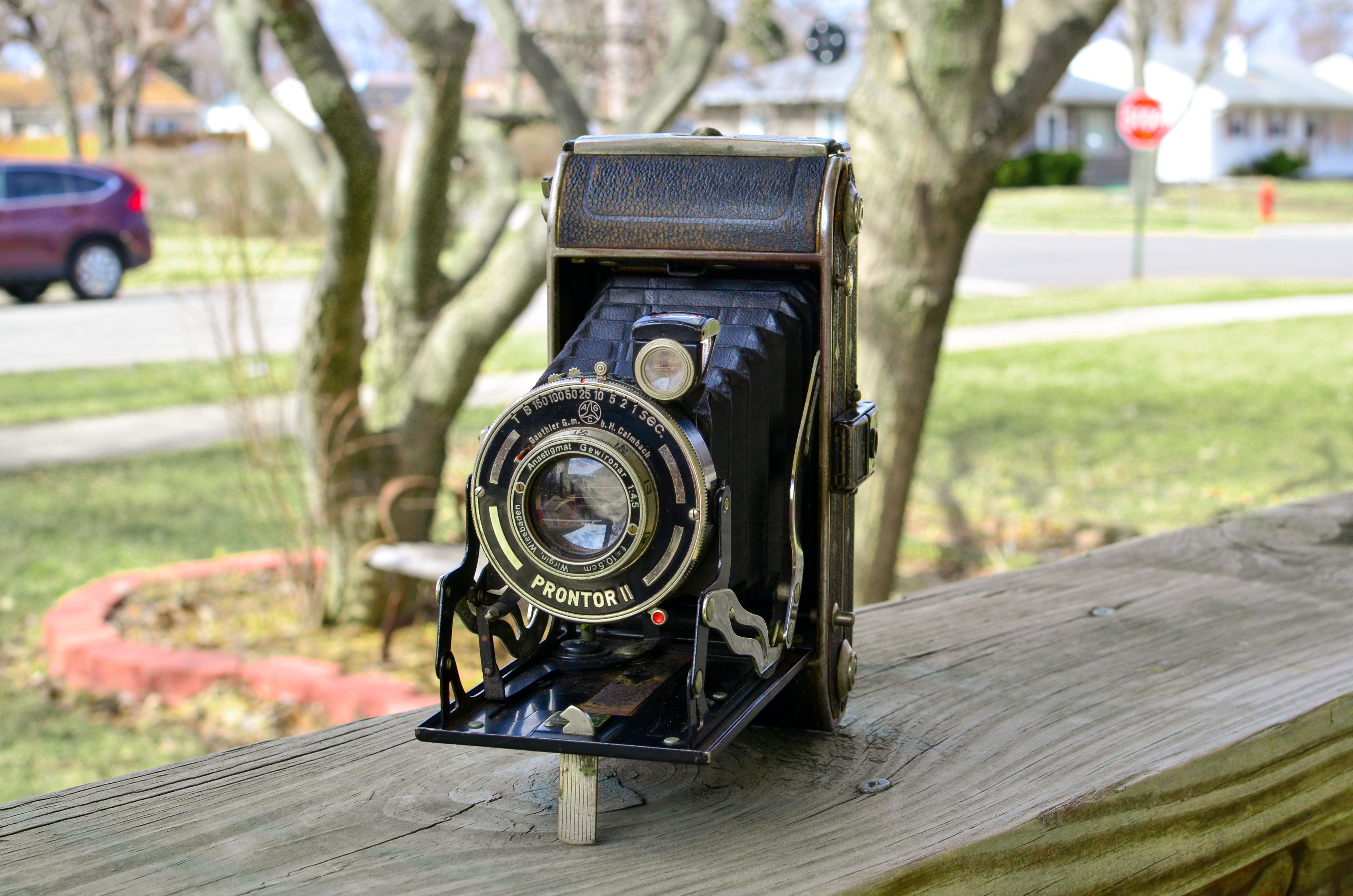
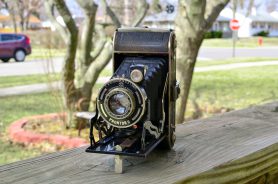










Great write up! There is something special about a 6×9 camera, and while they are admittedly film eating machines, the detail a good camera like this can pull forth can be amazing. I hope you can figure out the focal plane issue, as it seems you have a nicely preserved specimen!
Thanks for the compliments! One of these days, I need to gain access to some time of higher resolution scanner. When I look at the scans I get back with my film, 6×9 and 6×4.5 scans look to have the same level of detail. While it makes perfect sense that 6×9 should have more, I just dont think the scans that I get back from the lab can show it. Whenever I look at the shots from my Medalist, I think theres more there than I can see.
Mike, hi!
I was researching Auta models recently, and your web-site popped up first for some google searches. Great investigation!
One thing which I am still trying to figure out is – all Auta models were simplified versions of Presto, which had better lenses, leather covering, usually better shutters, and nickeled (chrome?) body edges. Auta models had black painted edges (with the exception of rounded body Auta, that one should be similar to Selo 20, but I have yet to find an example). Doesn’t it make your camera a Presto from 1935~1938?
I updated the following listings with my findings:
http://collectiblend.com/Cameras/Wirgin/Auta-(1935).html
http://collectiblend.com/Cameras/Wirgin/Presto-(1935).html
What do you think?
Thanks!
Eugene.
I picked up an Auta or presto, not sure as it has a Lens and marking I have not been able to locate. It doesn’t have the nickel plating but it does have a nice fast Compur 250 top shutter speed and a Rodenstock Trinar Anastigmat f3.8 lens. It bears the green label “Wirgin Wiesbaden” and a cursive engraved font “F. Deckel- Munchen” above the lens on the lens platter. It’s in very good condition, I believe it came from original owner, well stored with no fungus. or dust in the lens, bellows withstood flashlight test, focusing ring is smooth and shutter fires close to correctly through the whole range. I will shoot a roll and post the results, and in the meantime try to investigate the year and exact model I have the 2 ruby lenses for dual shooting possibilities with a mask but alas, as in your case, it must have been lost.
What’s the value on a camera like this? I have one and would like to sell